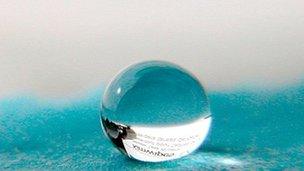Coating heals itself after damage
- Published

"Hydrophobic" surfaces repel water and grime but can be limited by short lifetimes
Scientists have taken a new approach to creating coatings that heal themselves when they are damaged.
The research could potentially have applications in scratch-resistant phones and "self-cleaning" cars.
"Functional" coatings that, for example, repel water and dirt have previously been dogged by relatively short lifetimes.
But the journal <link> <caption>Advanced Materials reports</caption> <url href="http://onlinelibrary.wiley.com/doi/10.1002/adma.201200807/abstract;jsessionid=D8C6CDB9A709C11FAAEB6BC5E472E952.d03t03" platform="highweb"/> </link> that researchers have worked out how to increase their longevity.
A major stumblingblock when applying these layers is that the smallest scratch can remove them, eradicating their special properties. It damages the nano-sized molecular groups that repel water and dirt, for example.
But this problem could be overcome by making a coating with self-healing properties. Such self-healing materials mimic living organisms that can repair their tissues.
Now, Prof Bert de With of the Eindhoven University of Technology in the Netherlands and his colleagues have discovered a nano-structure solution to the problem.
Affordable healing
Functional molecules - for example <itemMeta>news/science-environment-17852304</itemMeta> - can be coated onto the surfaces of products.
Prof de With and his team found that by attaching these molecules on the end of polymer "stalks" and mixing these throughout the coating, any that are removed by scratches are replaced by a new, self-orientating layer.
The result is that any coating, such as an antibacterial layer, would be "self-repairing" after small amounts of damage, as the molecular chains just below the damaged layer re-cover the surface.
The researchers were keen to stress that their work could prolong the life of functional surfaces and plan to develop the technology with industry partners.
Also, the new polymer enables a surface to repair damage automatically, without the application of any other materials, meaning that the new surfaces should be affordable.
The scientists hope that the new coating technology should be available in industry within the next six to eight years.
- Published29 September 2011
- Published26 April 2012